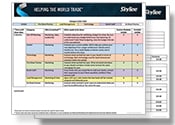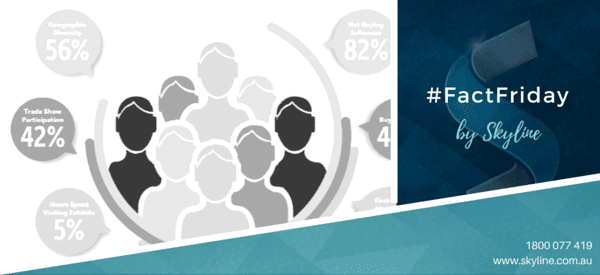Written by Anusha Suvarna, Skyline Displays Australia
Whether you’re a seasoned professional or just starting out in your field, attending your first trade show can be a bit of an overwhelming experience, but one that brings great value for your investment. For anyone looking to stay up to date on the latest trends and developments in the industry and explore new business opportunities, quite often it is at Exhibitions that new, vital industry initiatives are presented.
Here are some of the things you can expect.
1. Pre-show
Before attending a trade show, there are several things you will need to do. This may involve deciding on a budget, designing your booth, creating marketing materials, what products to showcase, and arranging logistics for shipping or transportation. Most importantly, your team presentation plays a crucial role in the show. Make sure your team is trained on your products and messaging, and are prepared to engage with your audience. Assign roles and responsibilities, such as greeting attendees, conducting product demos, and collecting contact information. A good prep before the show is the key to making the most of the opportunity and generating leads and meaningful connections for your business.
2.Networking Opportunities
Trade show attendees are often looking for new products or services to meet their business needs. Your booth provides an ideal platform to showcase how you can fulfill those needs. As an exhibitor, this is your ideal opportunity to connect with attendees, partners, and suppliers in your industry. In order to grab the attention, it’s important to be proactive at the event. Encouraging staff to have conversations with your audience, asking questions about their business needs, and exchanging contact information are the key points in the networking cycle. Also, keeping a track of people that you have a conversation with can help you to keep building the relationship. Be sure to check out these 5 innovative lead capture apps for trade shows.
3. Competitors
Preparing for your first trade show can be stressful and exciting at the same time, especially when it comes to dealing with competitors. Trade shows are super useful and you’ll be competing with other hundreds of exhibitors to grab your prospects’ attention. But to do so you must stand out from your competitors by having eye-catching booth designs, engaging promotional materials, and educational collateral. It is also crucial to do research on your competitors and understand their products and services. This will help you identify potential areas of differentiation to give you a better understanding of the industry.
Based on your industry research, develop a unique selling proposition that sets your products and services apart from what others have to offer. Make sure it’s clear, crisp, and conclusive. Most importantly, make sure your staff is trained to answer any question related to your products and services, resonates with USP, and has a pitch. Lastly, don’t be afraid to network with other exhibitors, including your competitors. This can help you gain insights into the industry and find potential opportunities for partnership or collaboration.
4. Follow-up
Post-show follow-up is a crucial step in making the most of your trade show and is one of the key drivers of business growth and success. Organize the contacts you have collected into a database or spreadsheet and take notes about their interest or needs. Prioritize the leads who have expressed interest in your products or services. Personalize your messaging to each contact point and reference any specific conversations you have discussed at the event. This can help you stand out and shows that you value the relationship. Mainly, make sure you set a timeline for your follow-up. You don’t want to bug your prospects with too many emails and calls. Also, this helps you follow through on your commitments thus creating credibility while demonstrating reliability.
5. Learning Experience
Trade shows are commonly viewed as a perfect marketing technique to promote a company’s products or services, network with others, and gather leads. But another benefit is that it is a perfect place for learning. Exhibiting at trade shows gives you a valuable learning experience. At your first trade show, make sure you are observing the way other companies are structuring their booth display, and things they are doing to attract prospects Don’t be afraid to ask questions of your attendees for feedback that can help you to showcase yourself better at your next show. Lastly, attend educational seminars and post-show events to connect better with your competitors and expand your knowledge and skills.
So, for a smooth exhibition experience, make sure you contact Skyline Displays where our 39 years of experience can guide you all the way.
If you need more information on graphics or would like to work with a Skyline consultant, feel free to contact us.
Trade Show Planning Timeline (PDF)
 Download this all-in-one trade show planning timeline to keep track of your trade show deadlines. Our timeline includes exhibit design & build tasks, technology considerations, pre-show promotions, booth staff tasks, lead management and miscellaneous items.
Download this all-in-one trade show planning timeline to keep track of your trade show deadlines. Our timeline includes exhibit design & build tasks, technology considerations, pre-show promotions, booth staff tasks, lead management and miscellaneous items.









